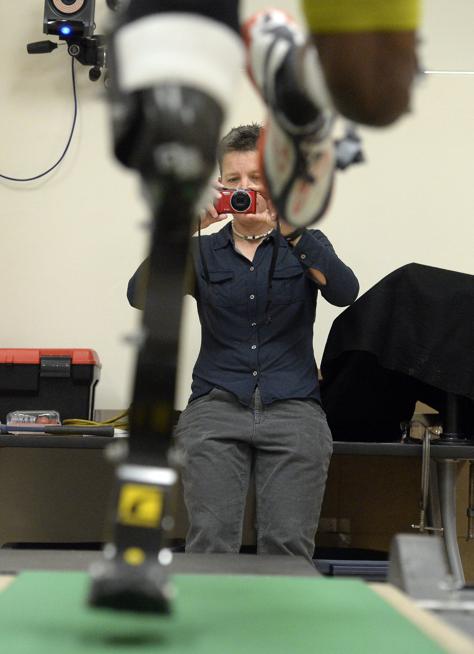Sixteen players from the U.S. National Sled Hockey Team partnered with the University of Colorado Boulder to learn ways to improve their performance in the sport.
Para-athletes took part in a multi-day study at the University of Colorado Boulder Recreation Center ice rink to test the effect of hockey stick length on performance, including metabolic effort, maximum speed and agility.
“There’s a zillion studies on every sport you can think of, but I think it gives sled hockey a lot of legitimacy that there’s serious research being done on the various issues that players face,” team member Declan Farmer said.
Farmer, a Paralympic gold medalist who studied at the University of Colorado Boulder, is a four-time world champion who completed his 12th season with the U.S. national team in May.
“I think it’s great that something like this is being done,” he said.
Sled hockey is a modified version of ice hockey for people with physical disabilities that was first introduced at the 1994 Olympic Games. Players ride in a custom-made sled with two hockey skate blades attached to the bottom. Players are given two hockey sticks with metal picks on the bottom to propel themselves forward. The rules of the game are almost identical to traditional ice hockey.
Farmer said the standard suggestion for stick length is that the tip of the stick should be at shoulder height while riding the sled, but he and his teammates all have different stick height preferences based on how they feel. Farmer said he’s looking forward to having data to back up or challenge those instincts.
“It was good to be able to test it a little bit from an objective numbers standpoint,” Farmer said.
The Paralympics have been relatively unstudied, said Alena Grabowski, a professor of integrative physiology at the University of Colorado Boulder, who has worked with para-athletes primarily in track and field. Her research focuses on understanding how equipment affects people’s movement, both at the Paralympics and elsewhere.
“It’s really rewarding because Paralympic athletes need a lot of specialized equipment to perform and compete,” Grabowski says, “and I feel fortunate to be involved in the research that will help support the best equipment for these athletes.”
On the first day of the study, each athlete completed a metabolic test: They skated around the ice rink with rest periods while wearing equipment that allowed researchers to measure their oxygen and carbon dioxide production. On the second day, the athletes participated in a top speed test and an agility course that mimicked competition scenarios, including sudden stops and turns.
During testing, three different stick lengths were tested to see which performed best.
Zane Colvin, a doctoral student at the University of Colorado Boulder, said it was “amazing” to work with the players during the study. They all knew each other well and turned out to have been training together for years. Some of the players could reach top speeds of nearly 20 mph, Colvin said.
“It’s a very unique experience to be able to talk to athletes at those levels and it’s a lot of fun,” Colvin said.
The research team is currently working on preparing a manuscript for publication in the coming months, so we await the results of their study.
“A lot of what we’re discovering is new. Sled hockey is not a very popular sport yet. It’s growing quickly, but there’s not a lot of research on it,” Colvin said, adding, “So a lot of what we’re discovering is interesting to see because no one has done it yet.”
Farmer said he was impressed with how the study was conducted. He said the researchers worked hard to learn the nuances of sled hockey to do the study properly. Farmer hopes the findings will encourage players to try other stick lengths to improve their performance.
“If the results were biased in one direction, say the longer pole was faster, that might motivate people to take the plunge and try it,” Farmer said.
In the future, this study could pave the way for new research into sports medicine and the impact of equipment on injury prevention in sled hockey.
“This is just the first step, and we hope to do more research in the future,” Grabowski said.
Colvin said the goal is to help athletes perform at their best from a research standpoint.
“If we can improve the athletes’ performance, it might help develop the sport,” he said, “and maybe help them win more gold medals.”

